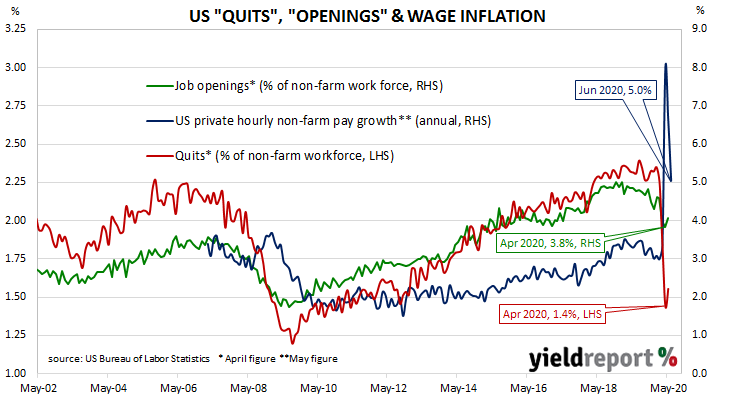Summary: US quit rate reverses course, rises; job openings up as well; total separations down; accommodation & food sales sector bounces back; openings-to-jobless ratio indicates “some time” for jobless rate to fall meaningfully.
The number of US employees who quit their jobs as a percentage of total employment increased slowly but steadily after the GFC. It peaked in March 2019 and then tracked sideways until virus containment measures were introduced in March. Quit rates plummeted as employment opportunities rapidly dried up.
Figures released as part of the most recent JOLTS report show the quit rate has staged a modest recovery. 1.6% of the non-farm workforce left their jobs voluntarily in May, a rise from April’s comparable figure of 1.4%. The largest source of additional quits arose from the “Accommodation & food services” and “Professional and business services” sectors while the “State and local government” and “Health care and social assistance” sectors experienced the largest monthly falls. Overall, the total number of quits for the month increased from April’s revised figure of 1.877 million to 2.067 million in May.
April’s non-farm payroll report indicated average hourly pay had jumped, possibly the result of fewer lower-paid jobs relative to higher paying ones. Figures from May and June then saw a fall in average hourly pay, with a corresponding fall in the annual growth rate from 8.0% in April to 5.0% in June.
Total vacancies at the end of May increased by 401,000, or 8.0%, from April’s revised figure of 4.996 million to 5.397 million, driven by large increases in the “Accommodation and food services”, “Retail trade” and construction sectors. Reduced openings in the “Information” and federal government sectors provided the largest drags. Overall, 10 out of 18 sectors experienced more job openings than in the previous month.
Total separations during the same period decreased by 5.83 million from April’s revised figure of 9.975 million to 4.145 million. The fall was once again overwhelmingly led by the “Accommodation and food services” sector, where there were 1.159 million fewer separations than in April. Separations decreased in 17 of the 18 sectors, the US Federal Government the only exception.

